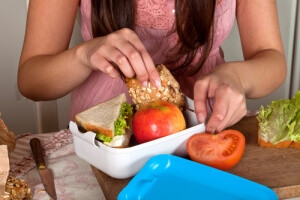 Most parents know the tyranny of the school lunch. Moms and dads have every intention of packing Johnny and Janie a healthy lunch, that are varied, nutritionally balanced so they will carry them from algebra through after-school sports.
Most parents know the tyranny of the school lunch. Moms and dads have every intention of packing Johnny and Janie a healthy lunch, that are varied, nutritionally balanced so they will carry them from algebra through after-school sports.
But when reality hits, they sometimes default to hurriedly throwing a Lunchable, a bag of chips and a package of cookies in a sack just before the bus comes.
A new school year is the perfect opportunity for kids and parents to start healthy — and convenient — lunch habits, nutrition experts say.
“This is the time for parents to bring their A game to what they’re packing for their kids,” said Susan Mitchell, an Orlando-based dietitian and nutrition consultant. After all, what goes in their lunches goes in their bodies. Among the tips local experts offer to get kids started on a healthy school year are these: Pack together, power up the protein, watch the sugar, avoid packages, go green and save some green.
Here’s how:
Get kids to help. Make planning and packing lunches a family affair, Mitchell said. The activity provides a great opportunity to talk about healthy food choices.
“Emphasize why it’s important to limit sugar and processed foods, and to fill up on nutrient-dense foods that are high in fiber and protein,” said Mitchell, who recommends working protein into every meal and snack. “Protein helps kids stay alert and gives them staying power.”
Start strong. Breakfast sets students up for their whole day. Make it high in protein and good fats, and low in processed sugar and carbs, say experts. Instead of cereal, Danish or bagels, try these protein-packed day starters: Plain Greek low-fat yogurt with fresh fruit stirred in, peanut or almond butter on whole-grain toast, or a hard-boiled egg with a piece of fresh fruit.
 Make it a power lunch. Before you throw together a bunch of packaged, processed foods, which tend to be high in sugar, sodium, processed carbs and additives, consider a healthier option, Mitchell said. Many other choices are just as easy, less expensive and far healthier. They just require a little creative planning. Mitchell suggests stuffing high-fiber wraps or whole-grain pita breads with vegetables, cheese and deli meat, or putting scoops of tuna, chicken or egg salad on a bed of lettuce and veggies. Make kebabs from last-night’s grilled chicken and vegetables. When making sandwiches, choose bread made from 100 percent whole grain, not just wheat flour, said Mitchell.
Make it a power lunch. Before you throw together a bunch of packaged, processed foods, which tend to be high in sugar, sodium, processed carbs and additives, consider a healthier option, Mitchell said. Many other choices are just as easy, less expensive and far healthier. They just require a little creative planning. Mitchell suggests stuffing high-fiber wraps or whole-grain pita breads with vegetables, cheese and deli meat, or putting scoops of tuna, chicken or egg salad on a bed of lettuce and veggies. Make kebabs from last-night’s grilled chicken and vegetables. When making sandwiches, choose bread made from 100 percent whole grain, not just wheat flour, said Mitchell.
Christopher Schnell, a pediatric dietitian for Florida Hospital’s Healthy 100 Kids, said to load up on fresh colorful fruits and vegetables and grains, and eliminate the packages. “Processed foods are usually high in sodium and low in fiber,” he said. The biggest problem Schnell sees in kids’ lunches are sweetened beverages, including sugary sodas or sports drinks, “which many think is a healthier alternative, but it’s not,” he said.
Pack water. “Whether pure and plain or sparkling with natural flavoring, water is a perfect source of healthy hydration without the empty calories of sugary sodas and sports drinks,” Mitchell said.
Plan power snacks. The average American kid takes in about a third of his or her daily calorie count from snacks, according to a recent study by Tufts School of Medicine. So make them count. Great grab-and-go choices include nuts, peanut or almond butter on high-fiber crackers, sprouted grain chips with tomato salsa or guacamole, strips of bell pepper and hummus, apple slices and string cheese. Busy parents can also stock up on small containers of unsweetened Greek yogurt, cheese sticks and high-protein, high-fiber energy bars, so kids reach for those snacks instead of chips and pretzels. Supply kids with a variety of nuts, dark-chocolate chips and dried fruit, and have kids make their own trail mix.
“If you can get kids to make the move from chips to hummus, you’ve really upped your game,” said Mitchell. Make it trashless; kids care about being green! One way they can be greener at school is by packing trashless lunches. Start with an insulated, reusable lunch sack. Pack foods in reusable plastic containers. Include a cloth napkin and some stainless silverware if it’s needed. Fill a reusable water bottle instead of packing a disposable beverage container. Nothing goes in the trash after lunch. You’ll not only save a bundle on baggies, but you will also help the environment.
Source: www.orlandosentinel.com; Marni Jameson;






